► Bugatti Chiron video review
► Chris Chilton is your guide
► €2.4m, 1479bhp, 0-62 in <2.5sec
The more things change – nascent piloted drive, creeping hybridisation, climatic carnage – the more things stay the same, and in Bugatti’s unspeakably indulgent world of money, speed and luxury that means one thing: that engine. For while the Chiron, the car that will grasp Veyron’s baton and run with it to 500 units costing at least €2.4 million apiece, is a new car by every significant indicator of these things (monocoque, coachwork, systems, performance, driving dynamics) there’s an old friend bolted to its composite rear bulkhead.
Chiron’s Judgement Day came long before Ferdinand Piëch’s departure from VW’s supervisory board, before dieselgate. It was May 2012 when key VW Group minds met under a flawless Spanish sky to sign off or kill off a number of projects. In a duotone split of polished aluminium and deep Atlantic blue, the prototype Chiron awaited its turn with Piëch, the man whose infamous inability to stomach negative answers had snatched Veyron from oblivion a decade earlier.
The bad news? Piëch wasn’t mad about the front-end styling, and suggested changes. The good news? The powertrain met its primary performance objective: 1500PS, or 1479bhp: nearly 300bhp up on the 268mph, 2.5sec to 62mph Veyron Super Sport. Thanks to the W16’s apparently limitless potential for power, Molsheim could embark on another era of fabulously exclusive performance engineering.
Click here for our full Bugatti Chiron review
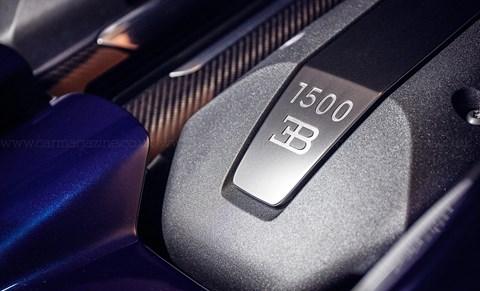
That remarkable power hike comes courtesy of some good old-fashioned hot-rodding. 1.4kg of weight’s been machined from the crankshaft, in part to allow a move to 16 new, much stronger titanium con-rods and four enormous turbochargers, units that dwarf even the coiled brutes that force-fed the Super Sport (they’re 30% bigger). Their vast dimensions, which usually come as a package deal with epic turbo lag as surely as grappa follows dessert, have forced a switch tosequential charging.
A pair of servo motors work valves in the manifolds, effectively blanking off one turbo on each side in low-demand conditions for immediate response, and opening them as required for peak boost (a heady 1.85 bar) when the devil rides. New big-bore intake and exhaust systems in weight-saving carbonfibre and titanium work to deliver the turbos’ charge unimpeded, and scavenge the combustion chambers of exhaust gasses as efficiently as possible. Power is up and so too is torque, with a gut-wrenching peak of 1180lb ft available from just 2000rpm.
For every action, a consequence. Chiron’s transmission is fundamentally the same seven-speed Ricardo DCT, necessarily uprated (new selector forks, new hubs, a revised lubrication system and new oil, given a fighting chance of staying somewhere useful under duress by carbonfibre anti-surge baffling), while the transmission uses a bigger crownwheel, stronger universal joints and stouter driveshafts.
A reinforced six-plate clutch has, after some 300,000 miles of testing and sufficient launch-control starts to savage 200 sets of bespoke Michelins, proven itself up to the job. Pity Bugatti’s head of production, Christophe Piochon, who also had to hot-rod the atelier’s in-house dyno with uprated rollers and cables like plump pythons to better cope with the additional current generated by the resistance motors.
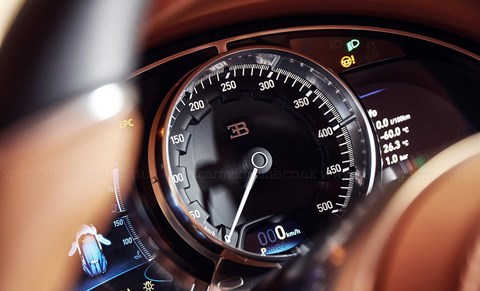
A powerhouse then, though head of engineering Willi Netuschil and his team are adamant that Chiron also eclipses Veyron on the rate and linearity of its throttle response. ‘Without sequential turbocharging the delay would have been significant, unacceptable,’ explains Netuschil. ‘With it the response is very fast and completely linear – each change in the angle of the accelerator pedal gives a corresponding increase in power. This is very important in a car with this much power, this much torque. And while the traces show a slight dip between the turbo phases, you cannot feel this.’
Does it feel faster? Piochon, a man who stopped logging his Veyron miles four years ago at 40,000, smiles and nods: ‘In the Veyron full throttle was “ooof”. In Chiron it is “urgh” – it gets you right here, in the stomach.’
And so that mighty engine went on dictating its requirements, issuing challenges, testing the resolve of those who would give it life and set it free in customer cars, to be leftidling in Dubai car parks and given death all day on private test-track playgrounds. For design director Achim Anscheidt it meant elegantly balancing one almighty thermal equation, and almost entirely opening up the rear of the car…
‘We have this dramatic cutaway rear now, reminiscent of the Porsche 918 and the McLaren P1,’ explains Anscheidt. ‘This was absolutely necessary for us. It was so challenging, to get rid of the heat that comes with such performance. Now it is sucked from the engine and from under the rear wings instantly, helped by the more tapered glasshouse.’ Spanning this great void is the Chiron’s greatest moment of visual theatre, a full-width homogenous LED rear light bar set in a single enormous arc of three-dimensionally sculpted aluminium. ‘One piece,’ grins Piochon. ‘You can imagine the size of the block we start with…’
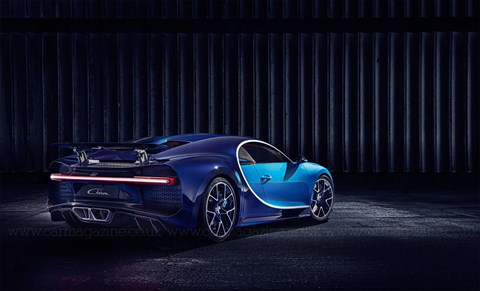
Linked to the need to get cool air into the car and hot air out is Chiron’s defining design element, an endless, elegant curve picked out in polished aluminium that runs low along the side of car before tracing a curve up, around the rear of the doors and forward to the base of the A-pillar. ‘You see this curve, the Bugatti line again and again in the old cars and even in Ettore’s signature,’ continues Anscheidt.
‘But to use it on these grounds alone would have been too romantic for such a technical car: form must follow performance. From our aerodynamic evaluations we knew that the air lower down the side of the car was low in pressure and turbulent. The air higher up, at the side window, is less turbulent and at a higher pressure, so the Bugatti line defines a highly effective air intake. The idea came from the engineers, from the package, but we incorporated the vents in a striking design solution.’
The Bugatti line’s a good example of the Chiron design philosophy generally; a familiar form, all-new execution. The face is cleaner than before; a broader nose, interrupted by fewer shut lines and colour splits, punctured only by the horseshoe grille and those ultra-slim, malevolent headlights. Venting abounds, feeding the front brakes (no fewer than three ducts feed each disc and caliper) and the bigger main radiator, but they’re cleanly incorporated, as befits Bugatti’s eccentrically luxurious take on ultra high performance.
Compare Veyron and Chiron side by side and you appreciate the new car’s more exaggerated form. It sits low on bigger wheels, the coke-bottling from cockpit to rear haunches more pronounced. And the surfaces are taut where Veyron’s were generous, pulled at times into spines and ridges that echo the still-startling Type 57 Atlantic of the 1930s.
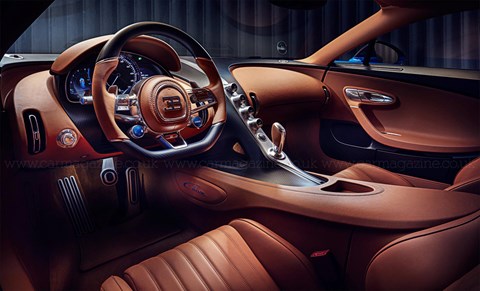
‘We have a new form language,’ says Anscheidt. ‘Veyron was generous in its proportions and surfaces. Now we have more extreme forms to define the body, with sharper lines thanks to the carbonfibre tooling we have perfected [air bladders to force the pre-preg carbon into the trickiest of shapes, and a multi-part mould requiring disassembly to extract each newly-formed panel in the case of the fiendishly splined rear deck]. When you have strong elements, like the Bugatti line, the rest of the design can be quieter, less fussy. The rear haunches are broad, like a Porsche 911’s, with reflections and a quality of surface that speak for themselves.’
Anscheidt’s labours clothe a new chassis that, according to Bugatti president Wolfgang Dürheimer, is Chiron’s crowning glory. ‘The steering, the lateral acceleration, the high-speed stability, ride comfort on cobbled streets – the improvements in all these areas are considerable. A Veyron owner will notice these immediately,’ he says. Just as the Super Sport was noticeably more alert, responsive and understeer-resistant than the original Veyron, so it’s claimed Chiron is a keener car should the mood strike.
‘Veyron had more understeer. Chiron breaks from the rear,’ smiles Piochon, and he should know. Indeed select the Handling drive mode (one of five, the others being low-speed Lift, the default EB Auto, ultra-stable Autobahn – the default north of 112mph – and all-out, key-armed Top Speed; each tweaking ride height, damping, power distribution, aero, steering, ABS and stability control) and Chiron will set its Haldex four-wheel drive and rear diff for ‘easy drifts’, so you can make like a Focus RS with four times the power…
The foundation of this dynamic re-invention is a new carbonfibre monocoque. Outwardly similar to the outgoing tub, it’s actually entirely new, wrought from a light but stiff laminate of carbonfibre inner and outer skins sandwiching a honeycomb core. A new front-end package (laid-down main radiator and a smaller, much lighter lithium-iron-phosphate battery under the passenger cell) has freed up the space for a modest luggage compartment.
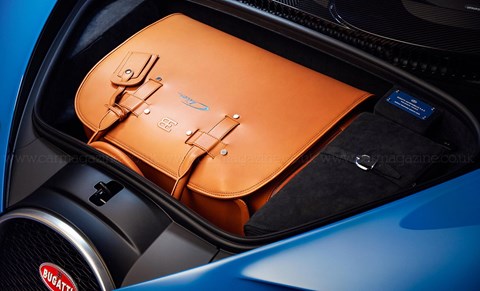
Suspension is by bespoke Sachs dampers that use motors to continuously optimise their behaviour, responding in less than 6 milliseconds. Multi-compound bushes and a trick, all-carbonfibre front anti-roll bar claim to bring a new level of refinement with no unwanted slop. AP has engineered an all-new braking system, with vast (420mm) carbon-ceramic discs and one-piece (for less twist and a firmer pedal feel) weight-optimised calipers (complete with eight titanium pistons up front) controlled by a new ABS module.
Intricate heat shields (‘A very expensive solution – you couldn’t do it in a normal car but on a Bugatti you can,’ laughs head of engineering Netuschil) protect the wheels and tyres from the brakes’ thermal fallout, while the rubber itself (285/30R20 front and 355/25R21 rear Pilot Sport Cup 2) ditches Michelin’s Pax run-flat system for mildly less expensive servicing.
And there, serene in the eye of this extreme engineering storm, sit two human beings, in a cockpit that’s now a little easier to access (similar sized apertures but clever door hinges) and more generous on headroom. Dominating the new interior are the instruments: a vast analogue speedo flanked, McLaren style (though Woking puts revs rather than speed centre-stage) by two displays; car information on the left, functions such as phone, DAB and nav on the right.
An analogue speedo, in this day and age? ‘For a boy looking through the window a TFT screen would be blank – there is no excitement there,’ says Dürheimer. ‘We stand for top speed, and you should be able to see that at all times.’ The VW Group MMI was deemed lacking in star quality so most of the controls are now on the wheel; shift paddles, media, modes and launch control – the tip of an electronics iceberg comprising no fewer than nine CAN Bus networks, three of which serve the engine alone.
‘With the Super Sport our engineers thought they’d tickled this car to the Holy Grail, but we have surpassed that with Chiron,’ says Dürheimer. ‘We had only ourselves to beat and we have done that. Our customers are hard to please – they have on average 63 cars – but when they experience the Chiron they will not be able to say no.’
Early sales figures would suggest Dürheimer’s half-right. Of 200 or so key clients solicited thus far, more than 160 – nearly one third of the total production run – have responded with money-down deposits. If the incremental increase in top speed, from the Super Sport’s road-limited 258mph to Chiron’s (equally limited) 261mph carries the tang of disappointment, the world’s car-buying elite doesn’t appear unduly concerned.
After all, opportunities to safely teleport from 0-62mph in less than 2.5 seconds are mercifully less rare than the right conditions for 260+mph cruising. With its limiter lifted, the numbers would suggest 287mph is within Chiron’s grasp… Truly the Molsheim thump is alive and well, and more compelling than ever. As head of design Anscheidt puts it: ‘Even supercar owners appreciate that this engine, this performance, is something different. In everything else the car eventually backs down as the engine struggles against drag. You just don’t have that with a Bugatti.’
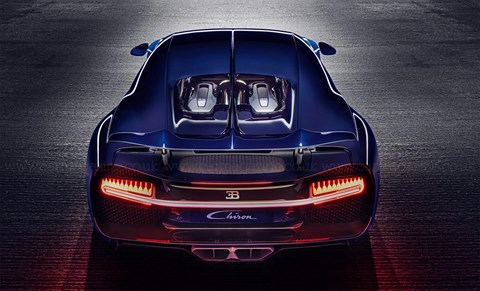
Veyron vs Chiron: how Bugatti moved the game on
Veyron
- Veyron’s W16 ushered in a new era of wanton power and speed. During the 450-car run output rose to 1183bhp in the Super Sport.
- Veyron brief a nightmare for transmission boffins Ricardo. 7-speed DCT slick and impressively resilient in the face of torque abuse.
- Initially inert dynamic character became progressively more alive and taut as Veyron gave way to agile Super Sport.
- Design always more shock and awe than traditional Bugatti elegance. Relatively low-tech cockpit dated fast.
- The road car’s Concorde moment and an engineering miracle. So accomplished Molsheim’s stuck to the same script.
Chiron
- Four far bigger turbos plus a little associated upgrading have added half the original car’s power output again.
- Driveline reinforced to cope. New drift mode shows Bugatti’s playful side; 1479bhp powerslides are go.
- Chiron continues the trend to a more involving hypercar. Oversteer – rather than lashings of safe push – now an option.
- New tub mounts all-new body. Style is cleaner, more cohesive and elegant than before. Cockpit a big step forward.
- Faster, more refined, more practical, more involving, quicker to speed and back down from it and only 50 units less exclusive…
Wasn’t the Galibier meant to be the next Bugatti?
Five years ago, when Wolfgang Dürheimer first joined Bugatti from Porsche, he was keen that the Galibier limousine should follow Veyron: a front-engined four-seater using the W16 and a version of the coupe’s DCT/four-wheel-transmission. At that stage much was still vague – dimensions, carbon or aluminium construction, mild hybridisation – but the car looked to be a certainty.
Less than two years later plans were shelved and Molsheim’s focus shifted to Chiron. The appetite to deliver Galibier remains – Dürheimer is extremely keen, seeing the car as one of which Ettore Bugatti would wholeheartedly approve – but the project must wait. ‘It was a question of being ready to go on a project of that scale,’ explains design director Achim Anscheidt. ‘It would have to be the ultimate car of its type, the ultimate four-seater, and it was perhaps too soon for us.’
The spec: Bugatti Chiron
Price: From €2.4 million
Engine: 7993cc, 64v, quad-turbo W16, 1479bhp @ 6700rpm, 1180lb ft @ 2000-6700rpm
Transmission: 7-speed dual-clutch, four-wheel drive
Performance: ‘Less than 2.5sec’ 0-62mph, 261mph
Suspension: Double-wishbone front and rear, adaptive dampersLength/width/height: 4544/2038/1212mm
Weight/made from: 1995kg/carbonfibre, aluminium
On sale: Late 2016
Read more Bugatti reviews